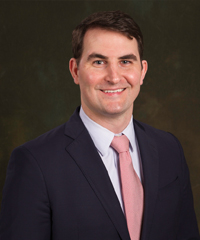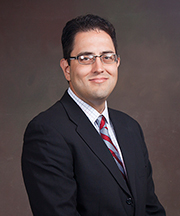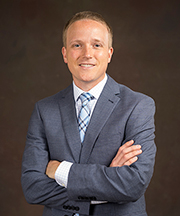- Anesthesiologist specializing in non-surgical spine care
Fellowship-trained in Interventional Spine
Stenosis
Overview | Causes | Symptoms | Diagnosis | Treatment | FAQ
Overview
Stenosis is a condition that can develop as a person ages, particularly
in those over 50. It is characterized by a narrowing of the spinal
canal, which places pressure on the spinal cord and nerves, because
there is not enough room for them. It resembles placing a ring on
your finger. If the finger becomes injured or inflamed, the ring
constricts and causes pain. The pain caused by stenosis is typically
focused in the low back area and can shoot down the legs and flare
up after walking or exercising.
[top]
Causes
Narrowing of the spinal canal may be genetic. However, the primary contributing factor to the development of stenosis is degenerative disc disease. As the spine undergoes changes in stability, density and size, this can result in less space for and more pressure on the spinal structures.
When one area of the spine is injured, it is more likely
that spinal health in other areas will fail. Conditions that may encourage
the development of stenosis include scoliosis, osteoarthritis, rheumatoid
arthritis, spinal tumors and trauma.
[top]
Symptoms
Symptoms of stenosis include a deep aching in the low back, buttocks
and thigh, and intense numbness or pain in the legs and sometimes
the shoulders. Symptoms can be brought on by walking and exercise.
If you have stenosis, you may notice that pain is sometimes relieved
by sitting or by a position in which the spine is flexed forward
and bending over. Consequently, people with stenosis may walk with
a hunched over posture and find that their pain worsens when bending
backward. Severe cases of stenosis will display more serious symptoms
such as loss of bowel and bladder function and loss of feeling in
an arm/leg.
[top]
Diagnosis
 Outlined below are some of the diagnostic tools that your physician
may use to gain insight into your condition and determine the best
treatment plan for your condition.
Outlined below are some of the diagnostic tools that your physician
may use to gain insight into your condition and determine the best
treatment plan for your condition.
Medical history: Conducting a detailed medical history helps the doctor better understand the possible causes of your back and neck pain which can help outline the most appropriate treatment.
Physical exam: During the physical exam, your physician will try to pinpoint the source of pain. Simple tests for flexibility and muscle strength may also be conducted.
X-rays are usually the first step in diagnostic testing methods. X-rays show bones and the space between bones. They are of limited value, however, since they do not show muscles and ligaments.
MRI (magnetic resonance imaging) uses a magnetic field and radio waves to generate highly detailed pictures of the inside of your body. Since X-rays only show bones, MRIs are needed to visualize soft tissues like discs in the spine. This type of imaging is very safe and usually pain-free.
CT scan/myelogram: A CT scan is similar to an MRI in that it provides diagnostic information about the internal structures of the spine. A myelogram is used to diagnose a bulging disc, tumor, or changes in the bones surrounding the spinal cord or nerves. A local anesthetic is injected into the low back to numb the area. A lumbar puncture (spinal tap) is then performed. A dye is injected into the spinal canal to reveal where problems lie.
Electrodiagnostics: Electrical testing of the nerves and spinal cord may be performed as part of a diagnostic workup. These tests, called electromyography (EMG) or somato sensory evoked potentials (SSEP), assist your doctor in understanding how your nerves or spinal cord are affected by your condition.
Bone scan: Bone imaging is used to detect infection, malignancy, fractures and arthritis in any part of the skeleton. Bone scans are also used for finding lesions for biopsy or excision.
Discography is used to determine the internal structure of a disc. It is performed by using a local anesthetic and injecting a dye into the disc under X-ray guidance. An X-ray and CT scan are performed to view the disc composition to determine if its structure is normal or abnormal. In addition to the disc appearance, your doctor will note any pain associated with this injection. The benefit of a discogram is that it enables the physician to confirm the disc level that is causing your pain. This ensures that surgery will be more successful and reduces the risk of operating on the wrong disc.
Injections: Pain-relieving injections can relieve
back pain and give the physician important information about your
problem, as well as provide a bridge therapy.
[top]
Treatment
In many cases, changing posture and using spinal injections can control the symptoms for a long period of time. Stenosis can be treated nonsurgically, but some cases require surgery in order to create more space around the nerves.
Pain can be relieved by flexing forward and bending over. Taking anti-inflammatories may be beneficial, especially ibuprofen products like Advil or Nuprin. Acetominophen (Tylenol) can be taken for pain, if you are allergic to ibuprofen. A physical therapy program can be followed that incorporates stretches and movements that extend the spine. Injections may be used to reduce inflammation and control pain symptoms. Try our home remedy exercises provided. Stop if they cause an increase in pain or symptoms.
The most common surgery to treat stenosis is called a
laminectomy, which helps create more space for the surrounding spinal
nerves.
[top]
FAQs
What causes spinal stenosis?
Although degenerating discs are the most common cause of spinal stenosis,
spinal tumors, injury, bone disease and other conditions can lead to
stenosis as well. For example, primary stenosis results from diseases
that are present at birth, while acquired stenosis is typically the
result of degeneration in the spine.
When should I see a doctor?
If pain interferes with your daily activities, you should consult a spine specialist to treat your stenosis. Leg pain that worsens is especially an indicator of spinal stenosis. This type of pain is not a normal part of the aging process.
What should I expect from treatment?
Treatment for spinal stenosis aims at minimizing the effects and symptoms of the stenosis but does not stop the progression of degenerative changes. Adopting a healthy lifestyle that includes exercise can help prevent disc degeneration. Click here to learn more about degenerative disc disease.
When is surgery seriously considered?
If your pain is severe enough or if walking has become difficult, your
physician may consider surgery as an option for you. However, nonsurgical,
conservative treatments are usually effective at treating spinal stenosis.
[top]
Non-surgical Spine Care
-
 Andrew “Gunter” Cain, MD
Andrew “Gunter” Cain, MD
Affiliated Spine Surgeons
can be reached at 501-224-0200
-
 Tim Burson, MD
Tim Burson, MD- Board-Certified
Neurological Surgeon
- Board-Certified
-

-

-
 Blake Phillips, MD
Blake Phillips, MD- Board-Certified
Neurological Surgeon
- Board-Certified
-
 Jonathan Reding, MD
Jonathan Reding, MD- Board-Certified
Neurological Surgeon
Fellowship-Trained Neurosurgeon
- Board-Certified
Back to Life Journal

Home Remedy Book

